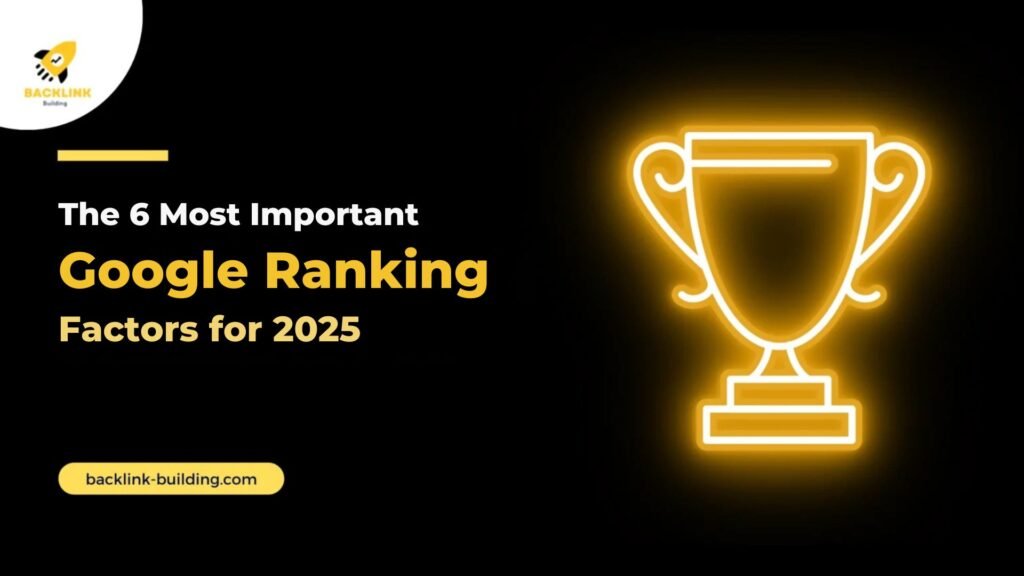
Websites must understand that Google’s algorithms consider over 200 ranking factors for SEO success.
Also, the ever-changing landscape of search engine optimization requires keeping up with the subtle complexities of all the various SEO and Google ranking factors for ultimate success.
So, in this guide, we’ll walk you through a comprehensive list of Google ranking factors that we know google uses.
Let’s dive right in.
What Are Google Ranking Factors?
Google ranking factors are the criteria that Google’s search algorithm uses to determine the order in which web pages appear in search engine results pages (SERPs). These factors help Google evaluate the relevance, quality, and authority of a webpage in response to a user’s search query.
Google uses over 200 ranking factors, but not all of them carry the same weight. Some are more critical than others in influencing a website’s search ranking.
Key Google Ranking Factors for Better SEO
Here are some key Google ranking factors that impact SEO in 2025:
Domain Factors
Google uses domain factors to create trust and boost the rank of domains displaying higher levels of credibility. It focuses on the ownership and quality of a domain. Here are eight essential domain factors:
- Domain Age: While many SEOs may think that Google naturally “trusts” older domains, John Mueller of Google has stated the age of a domain holds no bearing in its ranking.
- Domain History: This measures how long the domain has existed and how often it has changed hands. Domains with a long history are seen as more trustworthy.
- Top Level Domain (TLD): Generic top-level domains such as .com, .net, and .org are considered more authoritative than country code TLDs like .it or . The UK. And, also having a Country Code Top Level Domain (.cn, .pt, .ca) can sometimes help the site rank for that particular country.
- Exact Match Domain (EMD): If your website has an exact match domain (EMD) full of relevant keywords, this could be beneficial for its search engine rankings. However, if the content on your EMD isn’t up to par, you may be at risk of being impacted by future EMD algorithm updates.
- Domain Registration Length: Registering a domain for shorter periods can negatively impact rankings as google wants to ensure it is a trusted website that will remain for longer.
- WhoIs Privacy Protection: Google does not consider websites with private WhoIs information as being more authoritative or trustworthy than those with their information publicly visible in the WhoIs database.
- SSL Certificate: Even Google has confirmed HTTPS as a ranking signal. Having an SSL certificate installed on your website shows google you take security seriously, and can be a factor that google looks into when ranking websites.
- Subdomains: Subdomains have less domain authority than the primary domain, but they can still give google an indication of what type of website you’re running and help it determine how trustworthy it is.
Content Factors
- Content Quality: Quality is Google’s number one ranking factor, and it makes sense. Content with high-quality information, relevant facts, and in-depth research will consistently rank higher than content with shallow and duplicated content.
- Content-Length: Long-form content (over 2000 words) typically ranks higher on google than shorter-form content. However, it is essential to note that Google does not prioritize longer articles over shorter ones solely based on word count. Even the research conducted by backlinks has proven that the first-page google search results are about 1400 words.
- On-Page Optimization: This includes optimizing: title tags, meta descriptions, h1, h2, and h3 tags, image alt tags, etc.
- LSI (Latent Semantic Indexing keywords): LSI keywords are related words and phrases that google looks for when determining the relevance of a page to a query. Including them in your content helps google better understand what your page is about.
- Multimedia Content: If you want to gain visibility and authority on the top search engines, incorporating visuals such as photographs and videos into your content is vital. The integration of multimedia will not only help boost your rankings but also attract more attention from online audiences.
- Internal Linking: It desires a website with an easily recognizable architecture and internal linking strategy to demonstrate the most relevant pages on your site. This will make it easier for Google bots to traverse through and provide readers with effortless navigation around your website.
- Outbound links: They look for websites that link to high-quality and relevant external sources. which ensures that the content produced is of high quality.
- Reading Score: This is determined by google’s algorithms, which measure the readability of content. The easier your text is to understand and follow, the higher they will rank it.
Backlink Factors
- Quantity of Backlinks: They look at the number of backlinks a page has, but it is not the sole factor they consider when looking at backlinks. This is because google looks for quality over quantity when assessing backlinks.
- Domain Authority: They are the authority of domains from which you receive backlinks and the individual pages on those domains. The higher the domain authority, the more Google will consider your website authoritative and trustworthy.
- Anchor Text: They look at anchor text to determine the relevance of a page on your site about the search query being made. When google sees relevant anchor texts, it can assume that you have provided quality content around the keywords within them.
- Dofollow vs. Nofollow: It does not pass any link juice from nofollow links which means they do not help with rankings as much as dofollow links. However, Google still considers them when looking at backlinks profiles as they can add relevancy and trust to websites.
- Link Diversity: They value websites with various backlinks from different sources. This helps google believe that the links are organic and that your website has earned them naturally.
User Interaction Factors
- Bounce Rate: This metric helps them to measure how quickly visitors leave your website. If google sees that visitors are quickly leaving your website, it will assume the content is not relevant or valuable and lower its ranking.
- Click-Through Rate(CTR): It measures how often your website appears in google search results and how many clicks it receives to measure its relevance and popularity. If google sees that more people are clicking on your website than others, it can assume that your content is more relevant and helpful.
- Time on Site: They use this metric to measure the overall engagement of a website’s visitors. When Google sees visitors spending more time exploring a website, it can assume that the content provided is valuable and will boost its rankings accordingly.
- Pages/Session: This metric shows how many pages you view per session to measure the relevancy of a website’s content. The more pages google sees a user viewing, the more it can assume that your content is helpful and relevant.
- Return Visits: They also measure returning visitors when assessing the quality of a website’s content. If google detects that visitors are returning to your website, it can assume that they found what they were looking for and will reward the site.
- User Reviews: Google looks at user reviews when determining the rankings of a website, as it can provide invaluable information about how helpful and relevant content is.
Technical Factors
- Website Structure: When Google reviews a website, it focuses on the structure to determine its user-friendliness. Suppose they observe an organized and straightforward navigating design. In that case, they can presume that people can quickly locate the content they need and increase their rankings through search results.
- Mobile Optimization: As most google searches are now done on mobile devices, google looks at whether a website is optimized for mobile and how quickly it can be accessed. If google sees that your website loads quickly and is easy to navigate on mobile devices, then it’s a plus point for you.
- Page Speed: Google has suggested that a site that loads in less than 3 seconds is ideal, and sites that take longer than 10 seconds to load can be penalized. Even if google knows the content is relevant if your page takes too long to load google won’t rank it higher in the search engine results pages.
- Site Security: When it comes to security there’s nothing like google; they have stringent rules when it comes to security. Google carefully examines a website’s security to ensure it is not vulnerable to malicious attacks.
- HTML Code Structure: Google looks at the structure of a website’s HTML code when assessing its rankings as it can provide valuable insights into how user-friendly the site is. When Google sees that your website has clean and organized HTML, then it’s a plus point for you.
Google Algorithm Factors
well there are several updates, but here are the top 3 google algorithm updates:
- Panda: google rolled out in 2011; the panda update looks at the quality of content on a website to determine its rankings. Google checks for duplicate and thin content and keyword stuffing to ensure the page provides visitors with relevant information.
- Penguin: google released the penguin update in 2012 which focused on identifying spammy links back to websites and penalizing them accordingly. This helped google establish which sites were building organic links from reliable sources and which were taking shortcuts by buying or creating fake backlinks.
- Hummingbird: Google released this search algorithm in 2013, designed to better and more accurately understand user queries. Google can now interpret a user’s search intent and offer more relevant content.
So, these are the factors that Google uses to determine website rankings. If you want your website to rank higher on Google, then these are the main areas you should focus on optimizing.
Final Thoughts
Now that you know what google ranking factors are, you should be able to optimize your website accordingly. Bear in mind that Google is constantly evolving its algorithm so stay up-to-date with google SEO news and adjust your SEO strategy accordingly.
Don’t hesitate to contact us if you struggle with ranking your website. Additionally, if you have any queries, comment; we will be delighted to answer them!
Thanks for reading 🙂


